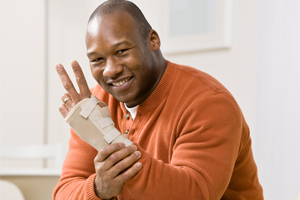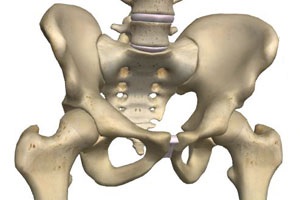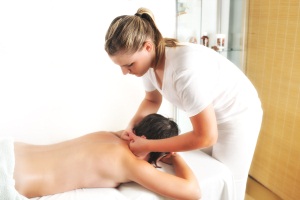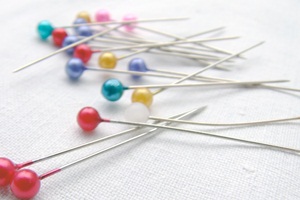5 Simple Steps to Treat Minor Sprains and Strains
 Whether you’re an athlete, avid runner, habitual gym goer or just trying to stay active, it goes without saying that feeling flexible and strong is important to you. In fact, it’s likely why you keep active. You want to enjoy your favorite physical activities. As we get older, minor injuries can be frightening and discouraging as we try to understand what the pain means and how to best treat it.
Whether you’re an athlete, avid runner, habitual gym goer or just trying to stay active, it goes without saying that feeling flexible and strong is important to you. In fact, it’s likely why you keep active. You want to enjoy your favorite physical activities. As we get older, minor injuries can be frightening and discouraging as we try to understand what the pain means and how to best treat it.
Sprain vs. Strain
Sprains occur when a ligament is torn; strains happen when a tendon or muscle tissue is torn. Minor sprains and strains can transpire when performing the simplest of tasks around the house, at the gym or on the job—especially if the affected area is not accustomed to the motion. The resulting knee, back, ankle or wrist pain can be intolerable. You’ll likely be unable to perform your usual daily activities until the injury begins to heal.
The RICE and Restore Treatment
Thankfully, there are five simple steps that you can use at home to overcome such an injury. We call it the RICE and Restore method:
- Rest, get plenty of it. It’s important to rest the affected area or joint as this gives it time to heal without aggravating the tear. Endeavor to keep the area immobile, and avoid putting pressure on it. You will likely find the support of a sling helpful as the damaged tissue heals.
- Ice, put it on the affected area. If it all possible, ice the affected area as soon as the injury occurs. Ice will reduce swelling and inflammation. It’s important to continue icing the area during the first 24 hours following the injury. Afterwards, you can rotate between heat and ice to alleviate pain and keep any additional swelling down.
- Compression, use it to reduce pain and swelling. The worst part of any sprain or strain is the accompanying pain and swelling. It can be excruciating. Wrapping an Ace bandage around the injury can help. Be sure to wrap it snuggly, but not so tight that it restricts blood flow.
- Elevation, elevate the injured area. Elevation is another means of keeping unwanted and painful swelling down. Try keeping the injured area elevated for at least the first 24 hours, and continue to elevate as able afterwards.
- Restore and reestablish movement gradually. After a few days, the pain should subside. At this time, you’ll want to gently move the injured area. Your goal is to gradually restore flexibility and strength. Be careful not to overwork the injured area, otherwise you’ll risk further damage.
In most cases, these five steps will remedy a minor sprain or strain within a few days or weeks, depending on severity. Anti-inflammatory medication can help reduce pain and swelling.
Chiropractic treatments have also proven effective in reducing pain and increasing mobility. We provide a complimentary foot, ankle and knee pain consultation if you’re concerned about whether you have a sprain or strain and how serious it is. You can receive peace of mind by taking advantage of this offer.
It’s important to treat minor sprains and strains with care. By carefully administering proper care and conditioning, you’ll be back to your active lifestyle in no time.
How Your Hip May be Causing Pain in Your Knees and Back and What to Do to Stop it
 Have you ever experienced pain in your back or knees? It could be because of your hip joints.
Have you ever experienced pain in your back or knees? It could be because of your hip joints.
The joint that links your pelvis (a strong support structure on which your spine sits) to your legs is known as the hip joint.
Your hip joint is a synovial ball-and-socket joint which means it is made up of a round ball portion at one end of the thigh bone and the domed socket portion of your pelvic bone.
This anatomy is what allows great freedom of movement of your hip joint. It allows you to stand straight upright while still giving you the ability to bend, kick, run, jump and just be very mobile.
On the other side of it, because your hips are made up of this ball-and-socket construction, they are also very vulnerable to too much movement which can lead to shifting and pinching and eventual wearing down of the joint, injury and pain. This vulnerability along with its central location to affecting many other areas of your body can make the hip joint quite the bully when it’s not working well.
More stable joints like the elbow or knee, which are hinge joints, only allow a joint to move primarily one direction. And while they can affect bones and joints nearby, they do not do this to the extent the hip joint does.
Believe it or not, because of the great amount of mobility in the hip, you can sometimes acquire injury and pain in your hip, knees and back just from sitting too long.
To understand how this happens, you need to realize how the hip joint is given strength. To stabilize the hip joint, you have strong muscles surrounding and aiding it for movement. They work to give the hips strength and stability and provide you with the motion you love. However, when these muscles are kept in a shortened or tightened position too long, with prolonged sitting for instance, they may stay that way when you get up too.
This means powerful muscles are pulling tightly on the hip joints even though you’ve stood up and started walking around and they should be at a more lengthened and relaxed position.
One of these big powerful muscles is called your iliopsoas muscle. It attaches by your spine – or your back bones and at your thigh bone (the femur). It works to raise your leg forward and rotate it outward. When it stays too tight because of prolonged sitting, it can pull the ball of the thigh bone forward in the domed socket and can pinch the hip joint, leading to pain.
Additionally, this tight muscle may pull tight and steady enough that it causes you to walk bent forward. When you’re bent forward, you have gravity working against you on most areas of your body which puts more stress on your whole spine all the way to your neck. This may also cause painful pinching of the joints in your back.
And if all that doesn’t seem harmful to your body, well-being and ability to move at your best…additionally, if your iliopsoas muscles are left tight and shortened, they can put more stress on your knees because they rotate your legs outward. Walking with a slight outward rotation in your knees can cause the knee joint to be off balance, not work well and eventually lead to abnormal wear and tear and pain in your knees.
As you can see, a small imbalance just from the hip muscles can lead to bigger problems in other areas of your body if they are not taken care of. But a bully can only stay a bully if left unchecked. Make sure you pay attention to your body and if you’d like an experienced opinion about what’s happening with your hips, back, or knees, we’ve helped hundreds overcome pain that holds them back from moving and feeling their best.
The 7 Ways to Get Rid of Painful, Tight Muscle Knots
 You may be intimately familiar with muscle knots in your body.
You may be intimately familiar with muscle knots in your body.
Practitioners sometimes refer to these knots as “trigger points”.
It’s the painful feeling of a tight muscle that just won’t release. It’s often felt when you aren’t doing a thing…it just keeps grabbing at you and sticks around when you wish it would go away.
Muscle knots occur when surrounding muscle tissue contracts around a hyper-irritable or stressed spot within the muscle. It causes hard nodules or bands to form along with tenderness, stiffness, and pain.
These muscle knots/trigger points may be the source of what’s called referred pain. This is the pain felt in one part of the body that is actually being caused by a trigger point elsewhere. Often, because of this, the trigger point and the pain do not appear related.
While the exact cause is not yet known, the following are leading reasons that muscle knots occur:
- Stress – either physical or psychological
- Chronic or sudden muscle strain, injuries, or accidents
- Infections
- A sedentary lifestyle
- Smoking
Usually our muscle knots involve a small area of muscle tissue that continually contracts. They can be deceiving because while the area is small, the pain can radiate to larger areas or even areas that contain no muscle tissue such as your joints.
As your tight, contracting muscle pulls on tendons and ligaments around a joint, it may feel like the pain is actually coming from within the joint itself when it is not. This can lead to a lot of unnecessary treatment that won’t solve the real issue.
Muscle knots often appear after a muscle spasm. Those knots then create additional muscle spasms elsewhere, leading to more knots in a sort of endless loop. A tightened muscle reduces the blood supply to the area creating an even greater problem since muscles deprived of oxygen-rich blood create lactic acid, which irritates the nerves and adds to the increased feeling of soreness in the muscle.
You will probably find that your particular trigger points are frequently located in the same places, such as a point in your shoulder that always seems to be knotted when you are under stress. However, this can change if efforts are made to get your body properly balanced.
The reason you should take these muscle knots seriously is because they can be a key cause of your headaches, neck, and back pain.
To help avoid the formation of knotted muscles, here are 7 ways to get rid of them:
- Relaxation is important. Learn to identify when you are holding muscles in a tightened position and then allow them to release.
- Use meditation, breathing techniques and exercise to handle stress.
- Be mindful of how you’re holding your body so you are not sitting awkwardly, lifting poorly, or holding your head turned during a presentation or movie for too long. Holding your shoulders high can also lead to strain.
- Be sure to drink enough water as it will flush out the toxins that tend to accumulate in the muscles that cause the vicious loop of muscle spasms.
- Get the proper nutrition — including sufficient amounts of potassium and calcium in your diet is essential for the health of your muscles. Bananas provide a good supply of potassium and green leafy vegetables are good sources of calcium.
- Stop smoking.
- Release painfully knotted muscles by breaking the cycle of spasms and knots. With a variety of proven techniques we can help prevent the same pain from returning again and again.
Life’s stresses will continue on as they do. You can however be released from the cycling grasp of painful muscle spasms. We even have experience helping those athletes who stress their bodies the hardest, finally get relief from pain. Put your whole body at rest and allow yourself to proceed through the day with ease. Contact us for an easy, no obligation consultation.
What the Feeling of “Pins and Needles” Really Means
 Everyone has experienced the sensation of “pins and needles” in their body at one point or another. It is a very common occurrence characterized by a sensation of tingling, pricking, burning, numbness or heaviness usually in the extremities. It is commonly referred to as having a limb that has “fallen asleep.”
Everyone has experienced the sensation of “pins and needles” in their body at one point or another. It is a very common occurrence characterized by a sensation of tingling, pricking, burning, numbness or heaviness usually in the extremities. It is commonly referred to as having a limb that has “fallen asleep.”
In most people, it is a temporary condition. However, if you experience this feeling on a regular basis, it is uncomfortable and leaves you weak with less mobility. This can be an indicator of several underlying medical conditions, some serious and some less so.
To begin a treatment to get rid of the pins and needles, it’s important that the cause of the underlying problem is identified. Without this, the pain will stick around or come and go indefinitely. We’ve helped many people who experience regular pins and needles finally stop the problem and get to the root of what’s going on so they feel pain-free and strong.
It’s time to learn why some areas of your body are constantly plagued with the uncomfortable pins and needles sensation.
This condition often happens when pressure is applied to the arms or legs such as when you are kneeling on a bent knee on the ground or sleeping on an arm for a prolonged period of time. This pressure reduces the blood flow to your limbs. The lack of blood stops the nerves from sending messages to the brain and therefore you don’t feel the limb, or in other words, it’s numb.
When you change positions the pressure on the blood vessels is released and after a period of time the blood flow returns to normal. After this, the messages from the nerves flood the brain all at once causing the pricking and tingling sensation we’re all familiar with.
Chronic pins and needles sensations are due to a problem with nerve function. There can be many causes for this, ranging from a vitamin deficiency to an autoimmune disease. It can also be caused by a pinched nerve or an injury to the nerves from disease or an accident. Pins and needles are common in the elderly, who often have reduced circulation in conjunction with a tendency toward vitamin B12 deficiency. As B12 must be absorbed by the gut, its absorption becomes more difficult as our digestive enzymes are not as strong as they once were.
Other conditions that pins and needles sensations may indicate are: diabetes, alcoholism, compressed nerves, carpal tunnel syndrome, spinal disc herniation, menopause, heavy metal poisoning, anxiety disorder, fibromyalgia, chemotherapy, multiple sclerosis, a transient ischemic attack (TIA) and lupus.
The sensation of pins and needles usually goes away by itself, but if you find yourself experiencing this or numbness on a regular basis or you think you need help with some of the problems listed above, come in for an exam or consultation. We can help you get your problem straightened out or direct you to the next step or referral that you may need. Also, by checking your body structure and alignment we start you out with the first easy step in diagnosing why the pins and needles may be present.
We can help a pinched nerve that you feel from your shoulders, in your back, or down your leg and from many other areas. You don’t have to suffer with the pain of a pinched nerve that slows you down and drains your energy. Together, we can decide upon the best course of treatment based on the specifics of your situation.
Managing Joint Pain that Comes with the Damp and Cold Weather
 It is common for people with chronic joint pain to feel more pain and stiffness when the weather turns damp or cold. Unfortunately it can make getting up and getting active hard to bear.
It is common for people with chronic joint pain to feel more pain and stiffness when the weather turns damp or cold. Unfortunately it can make getting up and getting active hard to bear.
While it’s easy to be skeptical when an elderly relative says his or her joints are predicting that it will rain tomorrow, it turns out they may be right. Essentially, our joints sometimes act as human barometers.
The pain you feel when the weather changes can decrease your regularly planned exercise or activity and starts throwing off your plan towards weight loss or keeping fit so you look and feel great and keep a high level of energy.
Researchers believe it’s not actually the cold, snow or rain that causes an increase in joint pain, but rather it’s the change in the outside barometric pressure that causes pain in your joints. Robert Jamison, PhD, a professor at Harvard Medical School along with several colleagues, performed experiments with chronic pain sufferers to investigate this phenomenon. The resulting study reported that “67.9 percent of the people surveyed reported that they can feel a change in their pain before rain or cold weather occurs.”
Does the pain you experience with weather changes mean that your joints are wearing down and getting arthritic?
Not always. If you’re feeling the same achiness for an extended period of time, it’s not just the weather affecting your joints. But it’s important to realize how your joints work. They have some fluctuation in the pressure and quantity of fluid that they hold. Jamison likens the joints to a balloon. “When a balloon is inflated, it has the maximum inside and outside pressure. High pressure that pushes against the body from the outside keeps tissues from expanding”…essentially keeping your joints in check. But when the weather changes and it gets cold, cloudy and rainy, as a very loose rule, the atmosphere is at a low-pressure which takes the pressure off of your joints which actually allows them to swell. This can put increased pressure on the nerves that are abundant in your joints and you feel pain as well as lack of motion (stiffness) from the swollen joints. “It doesn’t take much expansion or contraction of your tissue to affect a pain trigger,” Jamison adds.
Do you have to move to a warmer climate to get out of pain?
Moving to a warmer climate unfortunately will not help the problem in most cases. Jamison says “There’s no heaven on earth. If you have awful back or neck pain … there’s a good chance that that pain will travel with you.” According to Jamison’s research, there is no area of the country where people experience less pain. The patients with chronic pain who lived in San Diego reported just as much pain as their counterparts in Boston. Jamison says, “I think as mammals, we kind of adjust to our climate.”
Here’s what you can do to manage joint pain that comes and goes with the weather:
- Support your joints – Use joint supports (such as elastic knee bandages or support gloves for your hands) to keep tissues from expanding with the change in weather.
- Keep warm – Dressing warmly and applying a heating pad or hot water bottle to painful areas will help to relax your muscles and ease pain.
- Keep moving – Much as you may long to stay curled up under the duvet in bad weather, moving around will help keep your joints from stiffening. Our chiropractic treatments make sure your joints aren’t getting stuck and your body is moving well so your muscles and tendons don’t pull painfully during activities or even while resting. Once your joints are straightened out, you can continue making your body happy in motion by walking, running and doing some gentle yoga and stretching exercises.
Movement is a great way to keep pain at bay. So make sure that you don’t give up on the physical activities you’ve got planned just because the weather is bad. If you’re feeling the same achiness for an extended period of time, it’s not just the weather affecting your joints. Our treatment has helped many people experience pain relief sometimes as soon as the day we see them; within one visit.
Follow Us!